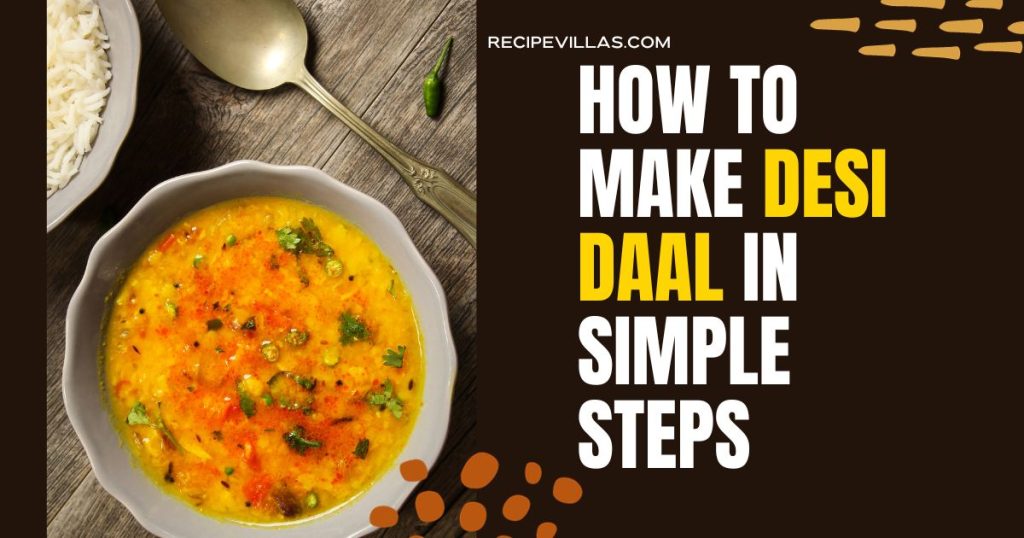
Desi dal, often simply referred to as “daal,” is a staple food in many South Asian countries, particularly India, Pakistan, Bangladesh, and Nepal. It is an integral part of the traditional cuisine in these regions and holds immense cultural and nutritional significance.
Daal is essentially a preparation of dried pulses or lentils, and it comes in a variety of forms and flavors.
Here’s an overview of Desi Daal:
Varieties:
Chana Daal: Made from split chickpeas, chana daal has a mild, nutty flavor and a slightly grainy texture. It is often used in soups, stews, and side dishes.
Masoor Daal: Red lentils, or masoor daal, cook quickly and turn into a soft, creamy consistency when cooked. They are often used in soups, curries, and even as a base for baby food.
Toor Daal (Arhar Daal): Toor daal is made from split pigeon peas and has a sweet, earthy flavor. It’s a key ingredient in South Indian sambar and is also used in a variety of other dishes.
Urad Daal: Black gram or urad daal is used to make dishes like dal makhani, a rich and creamy lentil dish. It is also used to make crispy fried snacks like papad and vada.
Moong Daal: Green gram or moong daal is known for its mild flavor and is commonly used in both savory and sweet preparations. It’s a key ingredient in the popular dish “khichdi.”
How to Make Desi Daal:
The preparation of desi daal generally involves boiling the lentils or pulses until they become soft and tender. Depending on the type of lentil, this can take anywhere from 20 minutes to an hour.
Various spices and seasonings are added to enhance the flavor, such as cumin, turmeric, ginger, garlic, and chili.
The cooked daal can be tempered with ghee (clarified butter) or oil and spices like mustard seeds, cumin seeds, and curry leaves to add depth and aroma.
Also Check Out: Pizza Omelet
Nutritional Value:
Desi daal is not only a delicious and versatile ingredient but also a highly nutritious one. It is a rich source of protein, dietary fiber, vitamins, and minerals. Lentils, in particular, are low in fat and provide a good amount of essential nutrients like iron, folate, potassium, and magnesium. They are also an excellent source of plant-based protein, making them a valuable component of vegetarian and vegan diets.
Cultural Significance:
Daal holds immense cultural significance in South Asian cuisine and is often considered a symbol of comfort and home-cooked meals. It is a part of daily life for many people in the region and is served with rice, roti (flatbread), or naan (leavened bread). Daal is also an important element of traditional feasts and celebrations, and there are countless regional variations and recipes passed down through generations.
Nutrition Facts of Desi Daal
Nutrition facts for a typical serving (1 cup, cooked) of Desi Daal (lentils) can vary slightly depending on the specific type of lentils used and the cooking method. Below is a general overview of the nutrition facts for cooked lentils:
| Nutrient | Amount per 1 cup (cooked) |
|---|---|
| Calories | 230 |
| Total Fat | 0.8 grams |
| – Saturated Fat | 0.1 grams |
| – Trans Fat | 0 grams |
| Cholesterol | 0 milligrams |
| Sodium | 1 milligram |
| Total Carbohydrates | 39.9 grams |
| – Dietary Fiber | 15.6 grams |
| – Sugars | 1.8 grams |
| Protein | 15.6 grams |
| Vitamin A | 0% |
| Vitamin C | 2% |
| Calcium | 2% |
| Iron | 25% |
| Potassium | 365 milligrams |
| Magnesium | 18% |
| Phosphorus | 24% |
| Zinc | 13% |
| Folate | 90% |
| Niacin | 3% |
| Vitamin B6 | 6% |
| Thiamin (Vitamin B1) | 6% |
Please note that these values are approximate and can vary based on the specific type of lentils and how they are prepared.
Additionally, desi daal may be prepared with various spices and ingredients that can impact the overall nutritional content.
It’s also important to consider portion sizes and any additional ingredients added when assessing the overall nutritional profile of your desi daal dish.
Conclusion
Desi daal is not just a food item; it’s a representation of the rich and diverse culinary heritage of South Asia. Its versatility, nutritional benefits, and cultural importance make it a beloved ingredient that continues to be cherished by millions of people around the world. Whether you enjoy it as a simple comfort food or as part of an elaborate feast, daal remains an integral part of the vibrant tapestry of South Asian cuisine.
